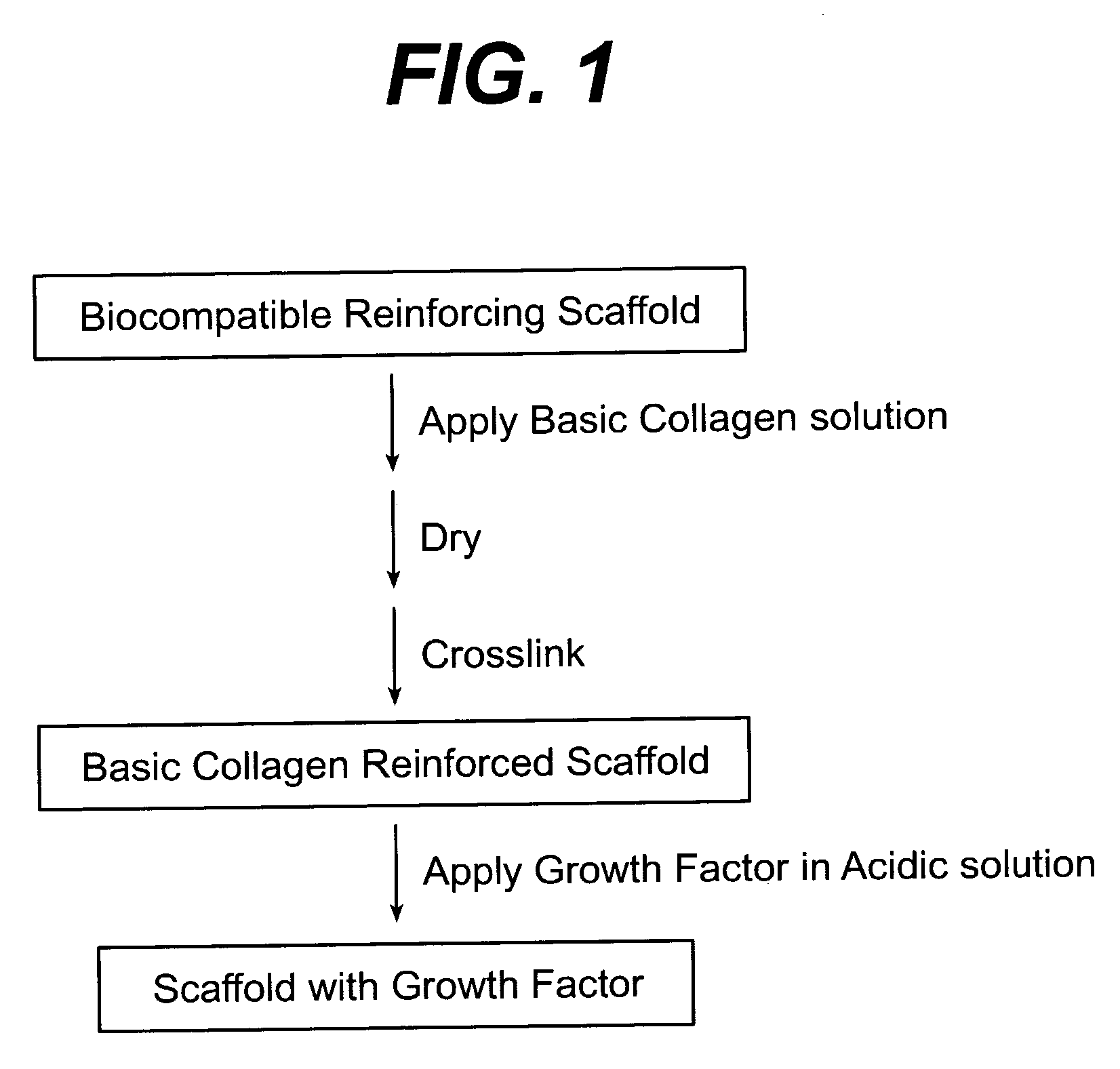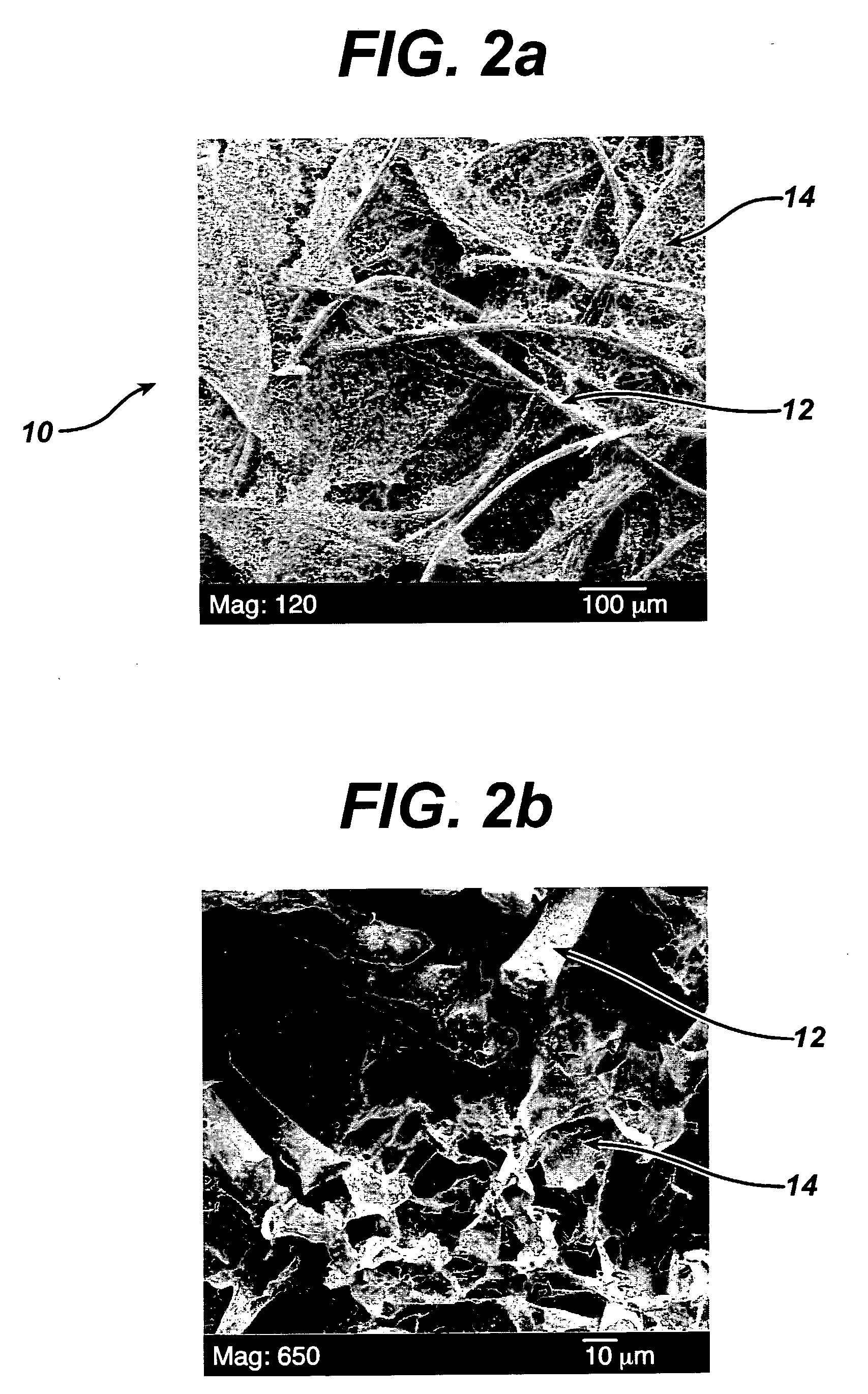Reinforced collagen scaffold
a collagen and scaffold technology, applied in the field of reinforced collagen scaffolds, can solve the problems of poor retention of growth factors, lack of mechanical integrity of collagen, and inability to support the tissue growing into the site of defects, etc., and achieve the effect of facilitating tissue infiltration and facilitating enhanced healing respons
- Summary
- Abstract
- Description
- Claims
- Application Information
AI Technical Summary
Benefits of technology
Problems solved by technology
Method used
Image
Examples
example 1
Preparation of Reinforced Basic Collagen Scaffold
[0038] A dry lay non-woven needle punched reinforcing fibrous structure was made of poly(lactide-co-glycolide) (PLA / PGA) fibers. The fibers, formed of a copolymer of lactide and gycolide with lactide to glycolide weight ratio of 10:90 (or 10:90 PLA / PGA) are sold under the tradename VICRYL sutures (Ethicon, Inc., Somerville, N.J.). The non-woven reinforcing structure had a nominal density of 108 milligrams per cubic centimeter, and a thickness of 2.14 millimeters. The non-woven was cut to final dimensions of about 10 centimeters×10 centimeters.
[0039] Soluble type I collagen (Kensey Nash Corporation, Exton, Pa.) was dissolved in 10 milliMolar sodium phosphate solution (pH 10.6) at a concentration of 5 milligrams / milliliter. The non-woven reinforcement was placed in a TEFLON-coated mold and completely soaked with the basic collagen solution. The basic collagen solution soaked non-woven structure was then lyophilized in a Durastop □P fr...
example 2
Retention of GDF5 in the Reinforced Basic Collagen Scaffolds
[0040] Reinforced basic collagen scaffold, formed as in Example 1, was cut into 10-millimeter diameter discs. A second dry lay non-woven needle punched reinforcing structure was made of 10:90 PLA / PGA fibers. This structure, however, was not soaked in basic collagen solution. This structure was also cut into 10-millimeter diameter discs.
[0041] Four discs of reinforced basic collagen scaffold were transferred into two 1.8-milliliter autosampler vials (VWR, West Chester, Pa.), two in each vial. Four discs that were not soaked in basic collagen were also transferred into two 1.8-milliliter autosampler vials, two in each vial. Into each of the four vials, 100 micrograms (as 200 microliters of a 0.5-milligram / milliliter solution) of RH-GDF5 (Biopharm GmbH, Heidelberg, Germany), was added. After incubation for 1 hour at 4° C., the RH-GDF5 solution was squeezed out and collected by pipetting. RH-GDF5 in the collected solution was...
example 3
Cell Attachment on Reinforced Basic Collagen Scaffolds
[0046] Reinforced basic collagen scaffold, formed as in Example 1, were cut into 4-millimeter diameter discs. Scaffolds were washed with phosphate buffered saline (PBS) 3 times and air-dried for 1 hour.
[0047] Eighteen of the reinforced basic collagen scaffold discs were then loaded with GDF5 by an addition of 16 microliters of a GDF5 solution made of 0.5 milligram / milliliter GDF5 in 10 milliMolar HCl to each disc. The target amount of GDF5 was 8 micrograms per scaffold. Another eighteen reinforced basic collagen scaffold discs were treated with 16 microliters of 10 milliMolar HCl. These discs served as controls.
[0048] Individual scaffolds were placed into a 6-well ultra low cluster culture plate (Coming Inc., Coming, N.Y.) and incubated for 1 hour. Primary bovine chondrocytes were isolated from young bovine shoulder. Bovine cartilage was digested overnight with collagenase (Worthington Biochemical Corporation, Lakewood, N.J.) ...
PUM
| Property | Measurement | Unit |
|---|---|---|
| Mass | aaaaa | aaaaa |
| Density | aaaaa | aaaaa |
| Density | aaaaa | aaaaa |
Abstract
Description
Claims
Application Information
 Login to View More
Login to View More - R&D
- Intellectual Property
- Life Sciences
- Materials
- Tech Scout
- Unparalleled Data Quality
- Higher Quality Content
- 60% Fewer Hallucinations
Browse by: Latest US Patents, China's latest patents, Technical Efficacy Thesaurus, Application Domain, Technology Topic, Popular Technical Reports.
© 2025 PatSnap. All rights reserved.Legal|Privacy policy|Modern Slavery Act Transparency Statement|Sitemap|About US| Contact US: help@patsnap.com


